This post may contain affiliate links via Amazon's affiliate advertising program. See privacy policy
Related Posts
- Smoked Rib Tips
- Pork Belly Bites
- Air Fryer Pork Tenderloin
Have you had really good Texas style brisket from one of your favorite bbq joints and thought it be great to make your own, but you had no clue where to start? Or perhaps like everything else, you hate how expensive things have gotten so you prefer to do it yourself. Either, this post will detail how to make delicious smoked brisket at home.
Welcome to the heart of barbecue country, where bold flavors and tender, smoky goodness converge. In this culinary journey, we dive into the revered tradition of Texas-style smoked brisket. Prepare to unleash the true taste of the Lone Star State onto your taste buds as we unravel the secrets and techniques behind crafting the perfect smoked brisket—juicy, flavorful, and a testament to the art of low and slow barbecue. Grab your apron, stoke the fire, and let's embark on a barbecue adventure like no other.
Texas Smoked beef brisket is as simple a recipe as there is, but you gotta believe in the process to get the pull apart with your hands tenderness, beautiful bark, and out-of-this-world flavor.
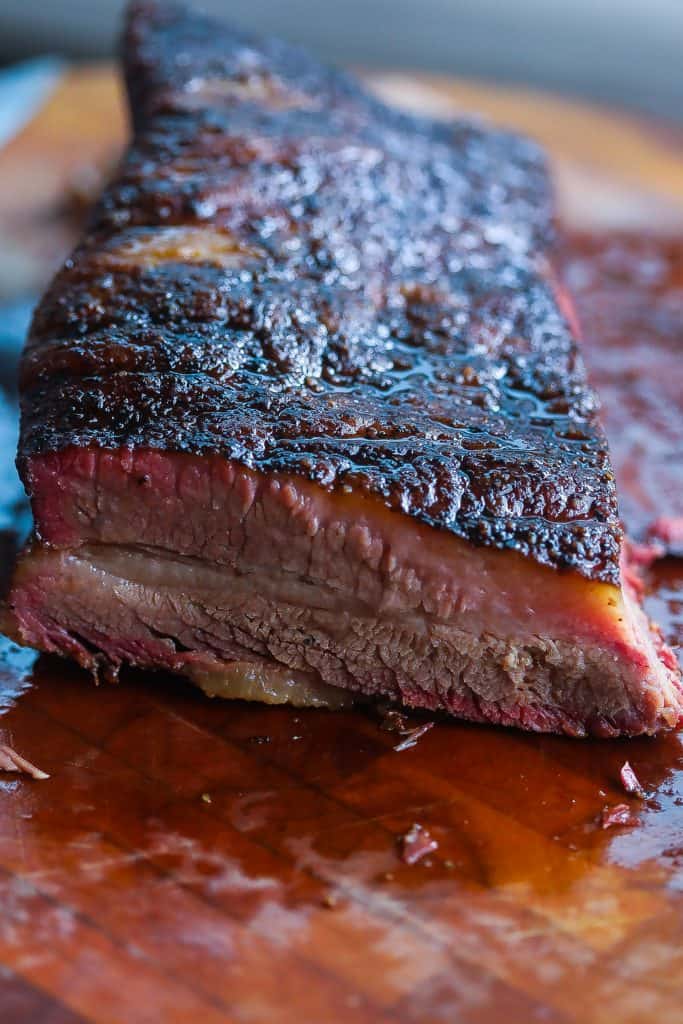
In many ways, smoking brisket is an exercise in minimizing variability in things like temperature, quality of the meat, types of seasoning, etc.
What Is Brisket
Beef brisket is a cut of meat from the chest or breast region of a cow. It's a tough and flavorful cut that requires slow cooking or smoking to break down the connective tissues and tenderize the meat. Brisket can be divided into two main portions: the flat (leaner) and the point (fattier). It's a popular choice for barbecue and smoking, producing a tender and juicy result when prepared correctly.
What's the difference between a brisket flat and a whole-packer brisket?
The flat cut and the point are two distinct portions of a beef brisket, each with its own characteristics:
Flat Cut (Brisket Flat): The flat cut, also known as the brisket flat, is a leaner and more uniform portion of the brisket. It is typically rectangular in shape and has a consistent thickness. This portion is characterized by its relatively low fat content and a more even grain. It's often preferred for slicing as it yields slices with a consistent texture and thickness.
Point (Brisket Point): The point, also known as the brisket point, is a fattier and more marbled portion located on top of the flat. This is part you ask for to get that real juicy brisket It is irregular in shape and contains more fat marbling and connective tissue. The point is known for its rich, juicy, and tender qualities. It has a more intricate grain and is excellent for making burnt ends or diced for stews and other dishes.
When cooking a whole packer cut brisket, you have both the flat and the point. Balancing the cooking of these two portions is important to achieve a well-rounded and delicious smoked brisket. Many pitmasters utilize both cuts to create a perfect balance of tenderness, flavor, and juiciness in the final dish.
A packer cut brisket is a large and untrimmed cut, retaining the fat and connective tissue, making it ideal for slow smoking or barbecuing. This cut offers a mix of leaner and fattier portions, resulting in a flavorful and tender smoked brisket.
Smoked Beef Brisket Ingredients
Salt, pepper, time, and wood smoke is the formula. Anything else is just extra nonsense or ego.
Packer Cut Brisket
Kosher Salt
Black Pepper
How to smoke brisket
Smoking brisket is all about time, lots and lots of time. You rub, smoke and wait essentially. However there are a few key rules/principles to follow to get to great as well as tips to help you best control for the many different variables.
Step 1: Season the brisket
Apply a thin layer of oil all over the brisket. Season generously with salt and pepper. And refrigerate overnight. Note the two different types of brisket cuts (lean flat cut vs. fatty point cut). A full "packer" cut includes both together. Most stores sell the packer, but a few will sell either flat (most common) or the fattier point (rare). Trader Joe's is the one place where you can find both. I recommend the packer unless you're cooking for smaller groups.
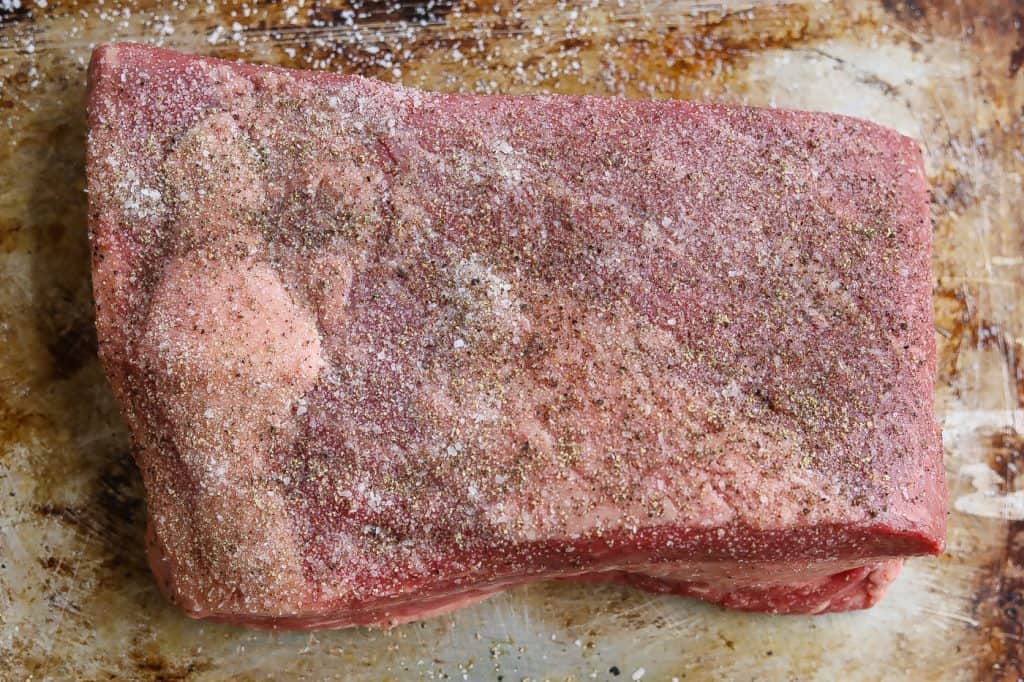
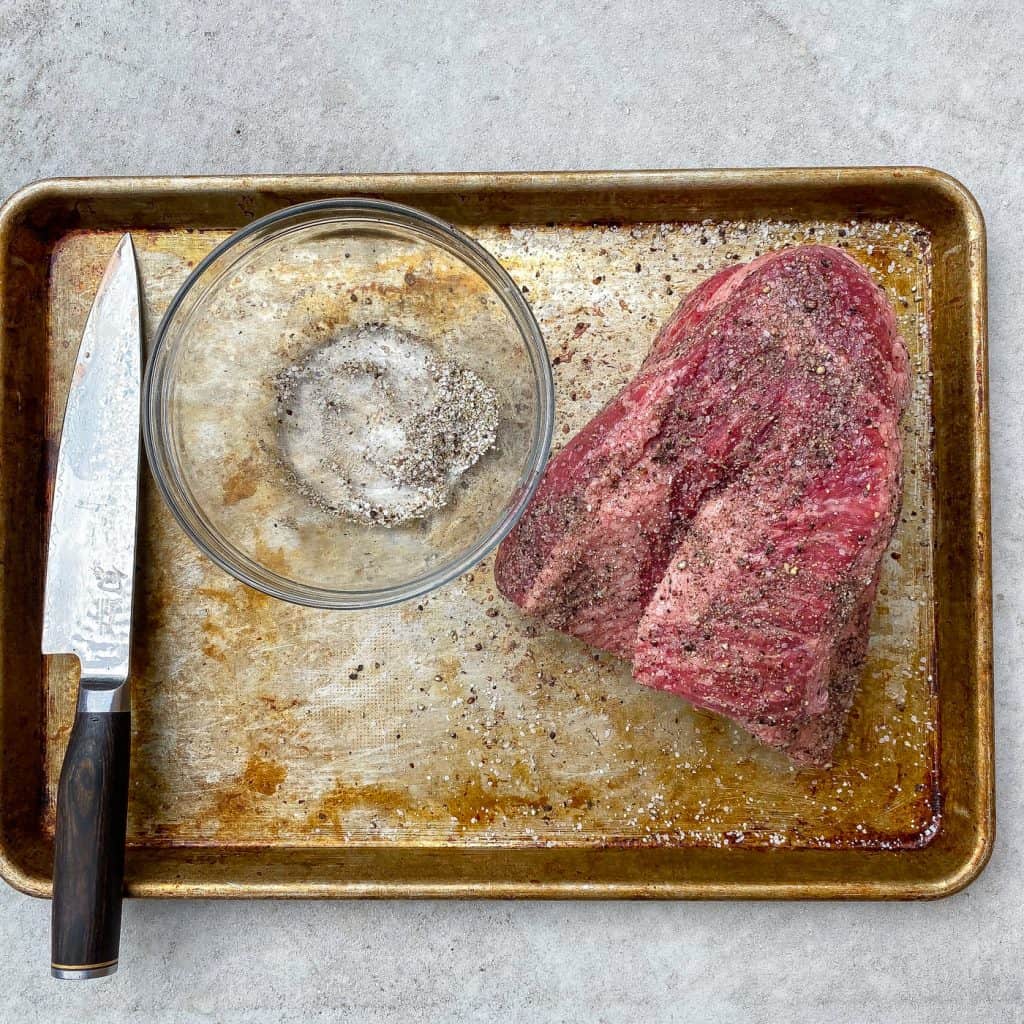
Step 2: Smoke until black
Prepare smoker for indirect cooking at 250 degrees F. Allow brisket to reach room temperature then add to the smoker with the point cut closer to the heat and the leaner flat cut facing away, but brisket fat side up
Smoke for 6-8 hours until brisket is a dark black color. Brisket will be around 165 degrees F
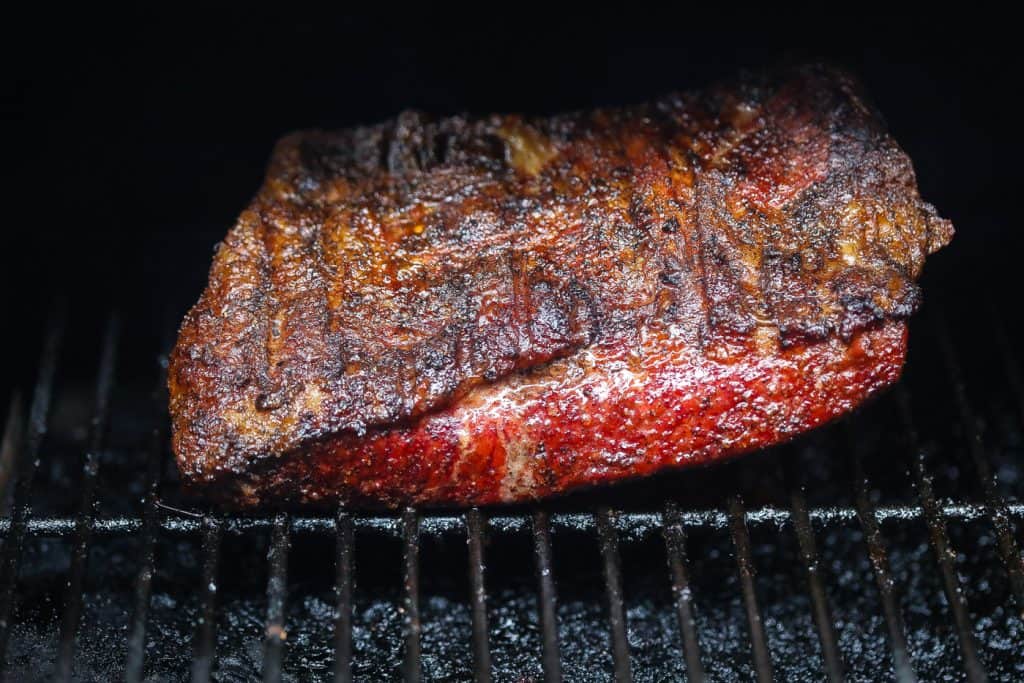
Step 3: Wrap for the brisket
Remove the cooked brisket and wrap tightly with the butcher paper. Lower the temperature to 225 degrees. Add wrapped brisket back to the smoker and cook til internal temperature is somewhere between 200-205 degrees F, 4-6 hours.
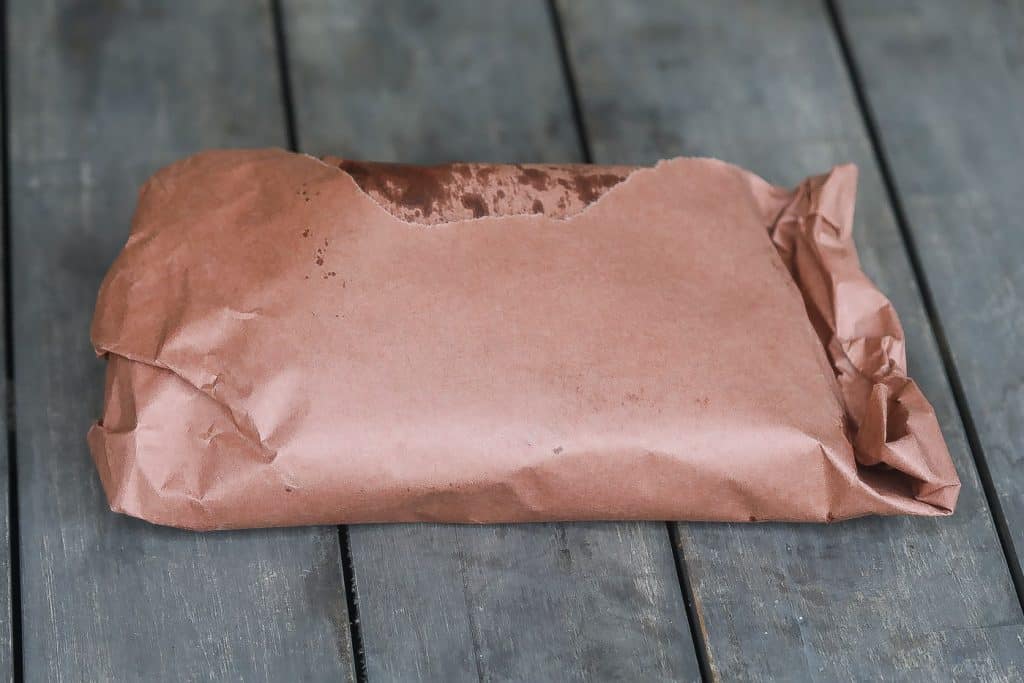
Step 4: Let the brisket rest before slicing
Take wrapped brisket off the smoker. Place in a cooler and top with old towels to keep insulated. Let rest 1-2 hours. To slice separate the point from the flat. Cut against the grain for tender cuts.

The Final Stretch: Resting and Slicing
Resting and slicing smoked brisket are crucial steps to ensure that your hard work and patience in smoking the brisket result in a flavorful and tender dish. Here's a guide on how to properly rest and slice your smoked brisket:
Resting the Smoked Brisket:
Remove from the Smoker:
Once the brisket has reached the desired internal temperature and achieved a good crust (bark), carefully remove it from the smoker.
Wrap in Butcher Paper:
Wrap the brisket tightly in butcher paper. This process, often referred to as "the wrap" or "Texas crutch," helps retain moisture and further tenderize the meat.
Resting Period:
Allow the wrapped brisket to rest in a well-insulated cooler or a warm oven (with the heat off) for at least 1 to 2 hours, or up to 4 hours. This resting period lets the juices redistribute throughout the brisket, ensuring a juicy and tender result.
Slicing the Smoked Brisket:
Unwrap and Collect Juices:
Carefully unwrap the brisket, making sure to collect any juices that may have accumulated during the resting period.
Locate the Grain:
Identify the direction of the grain (the muscle fibers) of the brisket. The grain typically runs from one end of the brisket to the other.
Slicing the Flat:
Start with the flat cut. Using a sharp slicing knife, slice against the grain to ensure tenderness. Cut slices that are about ¼ to ½ inch thick.
Slicing the Point:
Move on to the point cut. The grain may run in a different direction than the flat. Adjust your slicing accordingly to cut against the grain for the most tender slices.
Serving suggestions
I like my brisket with just pickles and red onions. Of course, I eat mine with my hands and maybe a slice or two of bread. I like to pair with something briny like a Collard Greens Slaw to help break up the fatty brisket.
You can never go wrong with a good Southern Potato Salad. It's the perfect counterpart to any bbq. I also like to include at least one bean/legume based sides like either "Texas Caviar" which is just a Black-eyed Pea Salad or these tangy and thick Instant Pot Baked Beans.
When serving smoked brisket, consider pairing it with a variety of sides and accompaniments to create a well-rounded and satisfying meal. Here are some popular options:
Classic BBQ Sides:
Barbecue Beans: Flavorful and hearty, a staple in BBQ meals.
Cole Slaw: Crunchy and refreshing, offering a contrast to the richness of the brisket.
Potato Salad: Creamy and comforting, a classic BBQ side dish.
Vegetable Sides:
Grilled Vegetables: Seasonal vegetables lightly grilled for a smoky flavor.
Roasted Brussels Sprouts: Crispy and caramelized, adding a nice touch of bitterness.
Corn on the Cob: Grilled or roasted corn with butter and seasoning.
Breads:
Cornbread: Sweet or savory cornbread complements the smoky flavors well.
Biscuits: Soft and fluffy biscuits can be a great addition.
Pickles and Sauces:
Pickles: Pickled cucumbers, onions, or jalapeños add a tangy and crunchy element.
BBQ Sauce: Offer a variety of BBQ sauces (spicy, sweet, tangy) for dipping or drizzling.
Extras:
Mac and Cheese: Creamy and cheesy macaroni and cheese is always a hit.
Deviled Eggs: A classic appetizer that's easy to prepare and serve.
Beverages:
Iced Tea: Sweet or unsweetened, a classic BBQ beverage.
Lemonade: Refreshing and perfect for a summertime BBQ.
What Is "The Stall"?
The "stall" refers to a common phenomenon that occurs during the smoking process of a brisket (or other meats) where the internal temperature of the meat plateaus or stalls, despite continued exposure to heat. This stall usually happens when the brisket is being smoked at a low and slow temperature, typically between 150 to 170 degrees Fahrenheit (65 to 77 degrees Celsius).
During this stall, the moisture on the surface of the brisket evaporates, causing a cooling effect that counteracts the heat from the smoker. This evaporation cools the meat, resulting in a temporary halt or slowdown in the rise of the internal temperature. The stall can last for several hours, and the internal temperature of the brisket may remain the same or increase very slowly during this time.
Briskets usually stall when the internal temperature is around 160 to 170 degrees Fahrenheit (71 to 77 degrees Celsius). The length of the stall can vary depending on factors like the size of the brisket, the smoking temperature, the humidity, and other environmental conditions.
To overcome the stall and achieve the desired internal temperature for a tender brisket, some pitmasters use the "Texas crutch" method. This involves wrapping the brisket in foil or butcher paper during the stall to reduce moisture evaporation, speed up the cooking process, and preserve the meat's tenderness. The stall is a natural part of the smoking process, and being patient during this phase is essential to attain a deliciously tender smoked brisket.
Tips for the Best Smoked Beef Brisket
- Choose the highest-quality brisket you can afford. You don’t have to go all wagyu beef, unless you got it like that, but quality does matter. With quality you’re looking for marbling; the more the better. In addition to quality, brisket comes in different sizes and cuts. You won’t a “packer cut” ideally; this cut includes the flat lean cut plus the fatty point cut. Some stores will sell one or the other cut, but when the full packer is available choose it. Grass fed and grain fed will cook at different speeds.
- Season with lots of coarse pepper and coarse salt. You really don’t need anything else or trickery. Trust the process. The big thing is to create a nice even layer on both sides.
- Place the brisket in the smoker on either side. It’s mostly a personal preference. I like fat side down to get a little more of a crust with the fatty parts. I do however make sure I cook the fattiest portion (point cut) closest to the hottest part of my smoker with the thinner, flat cut facing away.
- Temperature control varies by types of smoker, which makes it hard to give specific recipe directions for brisket. Ultimately you want to stay between 225-250 degrees F for the duration of the cooking. Cooking at too high temps will be problematic and leave you with tough, dry brisket. Likewise you don’t want to be constantly checking on the meat. Every time you open the lid the temperature drops. Good smokers or familiarity with your personal smokers allow you to set it (temp) and forget it which is ideal.
- About 3-4 hours into smoking your brisket will undoubtedly hit the “stall.” The stall refers to a point in time when after a steady progressive increase in internal temps your brisket will literally stall at a certain temp for a few hours. Don’t panic as this is normal. Stay the course, trust the process.
- Optional step: Keep butcher paper on hand to wrap your brisket along the way. This is like a cheat code to super moist brisket. You literally wrap the brisket tightly in the paper and then return it to the grill to finish cooking at 225 degrees F until the internal temps of the brisket reach about 200 degrees at the brisket’s thickest point. Butcher paper is nothing something I normally have on hand, so I just keep with the low and slow process and allow time and temp to break through the stall
- Rest the brisket, like for an unusually long time, as in at least an hour, but longer if you have the time. I like to place my still wrapped brisket in a cooler topped with towels. The rest is critical as it allows all those juices to trickle into all the different parts of the meat’s interior.
- Don’t slice the brisket until it has fully rested! If slicing a packer cut, split the point cut from the flat cut first and then slice each against their respective grains. Pay attention cause the grains go in different directions for the respective cuts.
- Fuel matters so choose a high-quality source. Hardwoods like cherry, apple, oak, maple, and pecan are great choices. I avoid mesquite because it has such a strong flavor which is not a good thing with such a long cook time. If using charcoal go with a good lump coal option.
- This recipe is for packer cut, but holds true for separate flat or point cuts if only one is available.
- Save the fat cap and use it as a seasoning in other recipes like braised cabbage. When you cook brisket fat all that rendered good stuff makes for a prime flavoring agent.
Common issues and how to avoid or fix them
Smoking brisket for 8+ hours means there is a high likelihood of something going wrong or not as well as planned.
Dry Brisket:
Cause: Overcooking or insufficient moisture retention during the smoking process.
Solution: Wrap the brisket in butcher paper during the cook to retain moisture, and consider spritzing the brisket with a liquid like apple juice or water throughout the smoking process.
Tough Brisket:
Cause: Undercooking or not allowing enough time for the connective tissues to break down and tenderize.
Solution: Extend the cooking time at a low, consistent temperature and ensure the internal temperature reaches the desired range for tenderness.
Frequently Asked Questions (FAQs)
How long to cook brisket at 250 degrees F?
This is a tricky question since there are so many variables to account for. Size of brisket plus the degree of temp control will factor in on smoking time. For example, the better built smokers do well at maintaining steady temperatures. A good rule of thumb is to plan for an hour per pound. It’s not exact but it’ll get you close.
The rest will just be experience and the use of a meat thermometer. Plan for anywhere between 12-18 total hours depending on all the different factors which also assumes you're not frequently opening your smoker creating temperature drops.
What is the best wood for smoking brisket?
For the most part, wood choice for smoking brisket is a personal preference thing. There are several good options to choose from, but there are also some you should avoid. I prefer pecan, oak, or a combo of the two. For one we have plenty of each here in Texas and two both are on the milder side, which guarantees they will enhance the natural beef brisket flavor vs. totally masking and overpowering it.
Fruit woods like apple or cherry are also good options. Mesquite would be the wood to avoid. It has a very strong flavor profile and isn't a match for the long slow smoking process for making brisket.
What can I do with leftover brisket?
Brisket is a large cut of meat, so I typically have leftovers, which is the fun part. I like to cut up larger chunks of brisket and use to season collard greens or pinto beans cooked in an Instant Pot.
I will also mix it into Fried Rice which makes it a main dish item or even brisket chili. I add to my breakfast rotation as well in the form of Brisket Tex-Mex Migas.
Smoked brisket is also perfect for grilled cheese sandwiches. Probably my favorite are smoked brisket birria tacos.
Lastly, it makes for a great appetizer as stuffed avocados.
How will I know when the brisket is done?
Old school guys just know or do things like the tongs test where they lift the brisket from the middle with the tongs and eyeball the amount of bend. The easiest fail-safe way is just to use a meat thermometer, measuring at the thickest part. 200 - 205 degrees F is the goal.
How long to rest brisket?
I've cooked my brisket late at night and rested my brisket in a cooler for 8 hours. The tighter you pack the cooler, the easier it is to maintain temps for an extended period of time. I have a bunch of old towels that I stuff in the cooler. Don't worry though, as you don't have to rest your brisket for 8 hours to get quality smoked brisket. However, at minimum you should let it rest for an hour.
For similar smoked recipes, try these:
Make This Smoked Brisket Recipe
If you make this smoked beef brisket recipe or any other from the site, please come back and leave me a comment below with your feedback.
Definitely take a photo of the dish and be sure to tag #foodfidelity so that I can see them.
You can also keep up with my food exploits as well as original recipes! You can find me on Instagram, Facebook, Twitter, and Pinterest. If you like any of the music you find on the site, visit me at Spotify to find curated monthly playlists.
Lastly, go to my YouTube channel and subscribe to be notified when new weekly videos are uploaded.
Equipment
- Smoker
- Butcher Paper
Ingredients
- 12 to 14 lb packer cut flat and point cuts beef brisket, fat trimmed to ¼ inch
- ½ cup kosher salt
- ½ cup freshly ground black pepper
Instructions
- Combine the salt and freshly ground black pepper in a mixing bowl, then evenly season the brisket on all sides. Leave the brisket out to allow to reach room temperature
- Prepare the smoker for indirect cooking. Bring the temperature to 250° F.
- Place the brisket in the smoker with the fatty point tip closest to the heat. Leave the lid closed for 6 to 8 hours until dark brown bark is formed and the internal temperature is 165° F. Avoid peeking and leave the lid closed.
- Remove the brisket from the smoker and wrap it tightly in butcher paper. Place it back in the smoker and continue cooking until the internal temperature reaches between 200 and 205° F°.
- Carefully transfer the wrapped brisket to a cooler. Top with old towels, close the lid and let it rest for at least 1 to 2 hours before slicing it.
- To slice the brisket, separate the flat from the point cut. Slice both against their respective grains. Enjoy
Video

Notes
- Choose the highest-quality brisket you can afford. You don’t have to go all wagyu beef, unless you got it like that, but quality does matter. With quality you’re looking for marbling; the more the better. In addition to quality, brisket comes in different sizes and cuts. You won’t a “packer cut” ideally; this cut includes the flat lean cut plus the fatty point cut. Some stores will sell one or the other cut, but when the full packer is available choose it. Grass fed and grain fed will cook at different speeds.
- Season with lots of coarse pepper and coarse salt. You really don’t need anything else or trickery. Trust the process. The big thing is to create a nice even layer on both sides.
- Place the brisket in the smoker on either side. It’s mostly a personal preference. I like fat side down to get a little more of a crust with the fatty parts. I do however make sure I cook the fattiest portion (point cut) closest to the hottest part of my smoker with the thinner, flat cut facing away.
- Temperature control varies by types of smoker, which makes it hard to give specific recipe directions for brisket. Ultimately you want to stay between 225-250 degrees F for the duration of the cooking. Cooking at too high temps will be problematic and leave you with tough, dry brisket. Likewise you don’t want to be constantly checking on the meat. Every time you open the lid the temperature drops. Good smokers or familiarity with your personal smokers allow you to set it (temp) and forget it which is ideal.
- About 3-4 hours into smoking your brisket will undoubtedly hit the “stall.” The stall refers to a point in time when after a steady progressive increase in internal temps your brisket will literally stall at a certain temp for a few hours. Don’t panic as this is normal. Stay the course, trust the process.
- Optional step: Keep butcher paper on hand to wrap your brisket along the way. This is like a cheat code to super moist brisket. You literally wrap the brisket tightly in the paper and then return it to the grill to finish cooking at 225 degrees F until the internal temps of the brisket reach about 200 degrees at the brisket’s thickest point. Butcher paper is nothing something I normally have on hand, so I just keep with the low and slow process and allow time and temp to break through the stall
- Rest the brisket, like for an unusually long time, as in at least an hour, but longer if you have the time. I like to place my still wrapped brisket in a cooler topped with towels. The rest is critical as it allows all those juices to trickle into all the different parts of the meat’s interior.
- Don’t slice the brisket until it has fully rested! If slicing a packer cut, split the point cut from the flat cut first and then slice each against their respective grains. Pay attention cause the grains go in different directions for the respective cuts.
- Fuel matters so choose a high-quality source. Hard woods like cherry, apple, oak, maple, and pecan are great choices. I avoid mesquite because it has such a strong flavor which is not a good thing with such a long cook time. If using charcoal go with a good lump coal option.
Nutrition
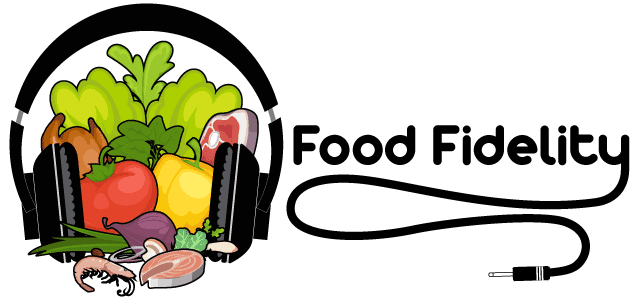

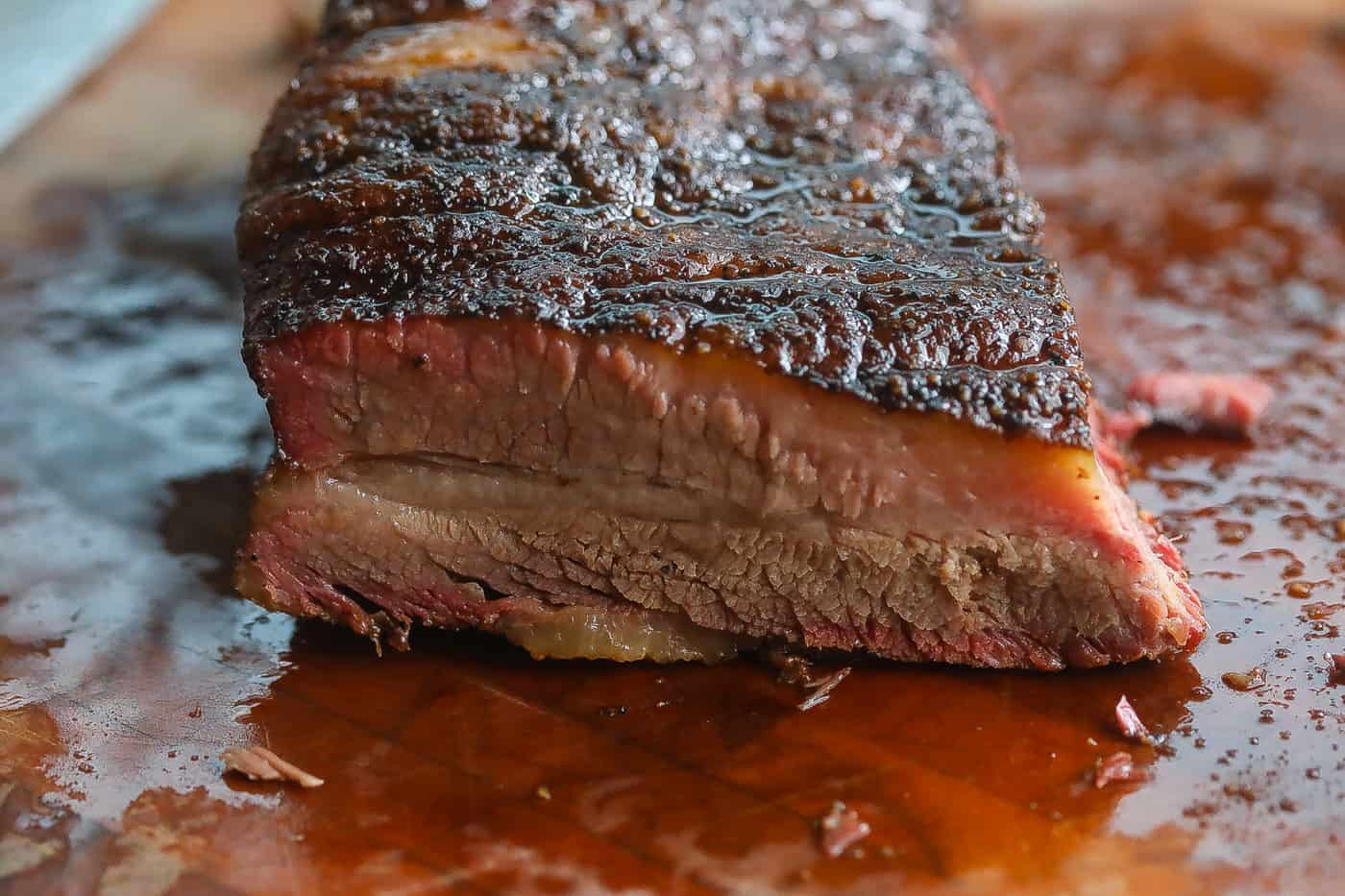
Jere Cassidy
Tuesday 1st of June 2021
I need to run to the store ASAP to get a brisket because this recipe has me drooling. Thanks for the tips on getting this right.
Marta
Tuesday 1st of June 2021
All of your tips are on the money. You know Texas is beef country and they take their brisket seriously around here! This recipe will get good use this summer.
Marwin Brown
Tuesday 20th of April 2021
Love it!
Mark rosemond
Tuesday 30th of June 2020
Brisket is a favorite. The kids are standing by waiting for me to cut it.
Marwin Brown
Tuesday 30th of June 2020
that's good stuff